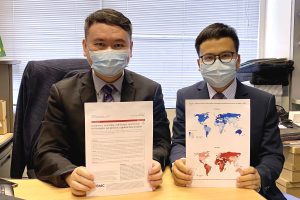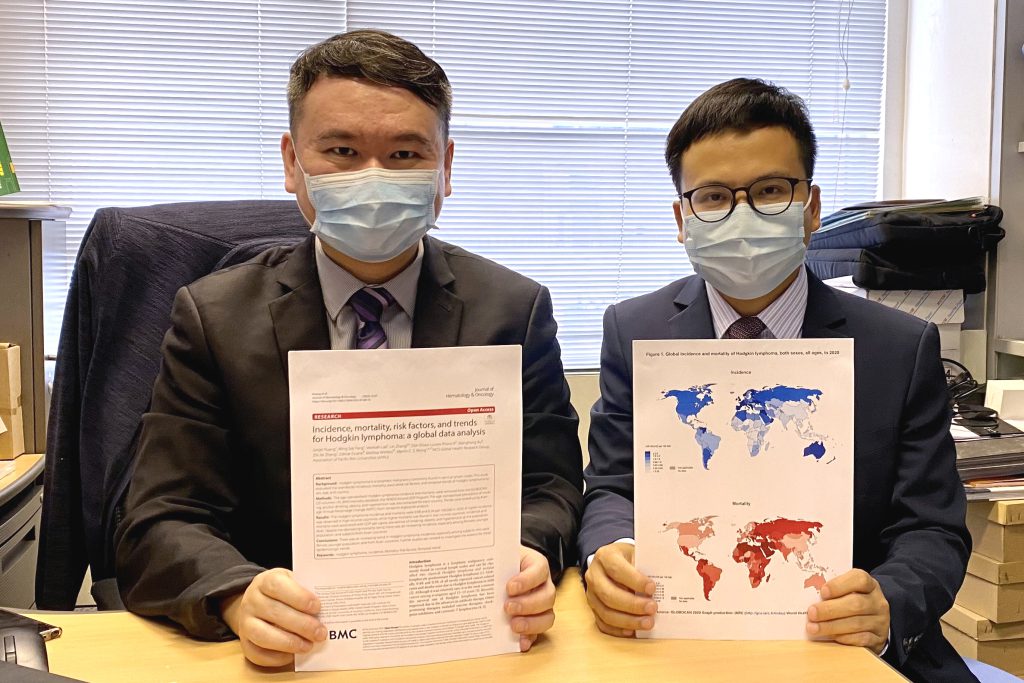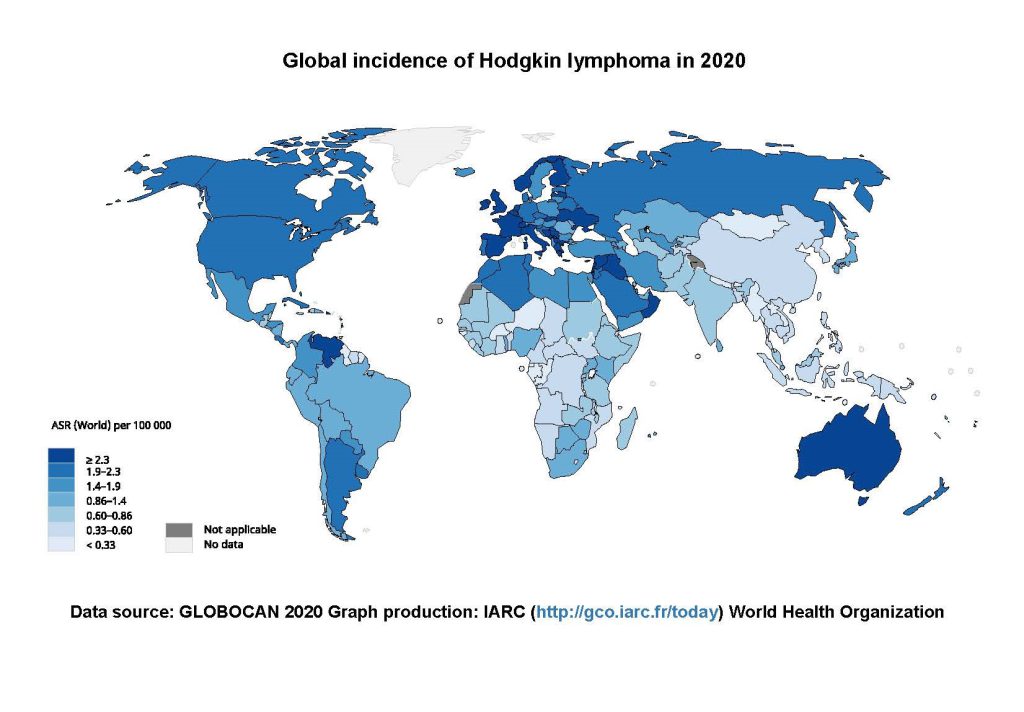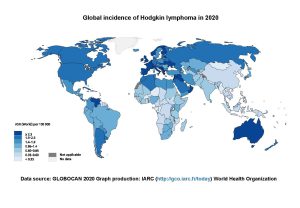CUHK
News Centre
CUHK finds the largest rise in incidence of Hodgkin lymphoma in Asia
Rising trend of male incidence means Hong Kong tops the world
Lymphoma is one of the top 10 cancers in Hong Kong. The main subtypes are Hodgkin lymphoma and non-Hodgkin lymphoma, of which the former is more common among young people. The Chinese University of Hong Kong (CUHK)’s Faculty of Medicine (CU Medicine) has conducted a study with the Association of Pacific Rim Universities (APRU) to investigate the global distribution, risk factors and epidemiological trends of Hodgkin lymphoma. The results showed that the incidence of Hodgkin lymphoma was higher in high-income places.
The incidence of Hodgkin lymphoma in Asia has also shown an obvious rising trend in recent years, and the rise in incidence of Hodgkin lymphoma in Hong Kong males was the largest in the world. The researchers recommended that risk factor control and early cancer detection should be implemented for high-risk populations to control the rising numbers. Details of the study have been published recently in the international journal Journal of Hematology & Oncology.
Hodgkin lymphoma is more common in the younger population, with large regional differences in morbidity and mortality
Symptoms of Hodgkin lymphoma include painless swelling of cervical lymph nodes, loss of weight, fever and night sweats. Although the disease is rare, it is one of the most common cancers in the younger population. According to figures from the Hospital Authority in Hong Kong, over 60% of new Hodgkin lymphoma cases in 2019 were 44 years old or younger.
To understand the most updated geographical distribution and to identify the high-risk population groups, the research team retrieved data from international databases such as the Global Cancer Observatory, WHO mortality database and WHO Global Health Observatory data repository for the age-adjusted incidence, mortality and prevalence of different risk factors.
The researchers found that the disease burden of Hodgkin lymphoma varied across regions, with southern Europe having the highest incidence (2.8 per 100,000 population) and West Asia the highest mortality rate (0.59 per 100,000 population).
In addition, the disease burden of Hodgkin lymphoma was proportional to the per capita gross domestic product (GDP) and the prevalence of smoking, obesity and hypertension. This implies that a country or region with a higher level of those risk factors will have higher morbidity and mortality from Hodgkin lymphoma.
Global Hodgkin lymphoma incidence is on the rise, while death rate is on the decline
The incidence of Hodgkin lymphoma globally has been on the rise in the past decade, and particularly in Asia. Using the “Average Annual Percentage Change (AAPC1)” for comparison, the largest increase in incidence rate among males was found in Hong Kong (6.23), followed by mainland China (5.99) and Japan (4.54). A relatively larger increase was found in females, which was most pronounced in Ecuador (18.7), followed by Kuwait (17.8) and South Korea (8.08).
There was also a significant increase in the incidence rate among people under the age of 40, with the highest in South Korea for men (12.2) and in Malta for women (14.0). In contrast, the trend in mortality from Hodgkin lymphoma has been decreasing, especially in Europe.
Dr. HUANG Jun Jie, first author of the study and Post-Doctoral Fellow from The Jockey Club School of Public Health and Primary Care at CU Medicine, stated, “The incidence and mortality of Hodgkin lymphoma vary by region, which may be related to detection and diagnosis ability, environmental factors, lifestyle and the prevalence of metabolic diseases in each place. It is worth noting that though the incidence of cancer is higher in high-income places, its mortality rate is higher in low-income places. The health equity issue involved is also an important research direction in the future.”
Professor Martin Chi Sang WONG, the senior corresponding author of the study from The Jockey Club School of Public Health and Primary Care at CU Medicine, added, “The overall incidence of Hodgkin lymphoma has been on the rise in recent years, but it is encouraging that the mortality rate has declined because of advances and accessibility of treatment. This study also shows that smoking, obesity and hypertension rates are important drivers of the increasing trend. Policy makers in different regions should implement evidence-based, targeted prevention strategies to control relevant risk factors.”
This study is a collaboration with Professor Mellissa WITHERS, the Director of the APRU Global Health Program; Keck School of Medicine, University of Southern California. The APRU was established in Los Angeles in 1997 by the presidents of UCLA, Berkeley, Caltech and the University of Southern California. It now has a membership of 60 leading research universities from around the Pacific Rim. CUHK is an important member of APRU, and Professor Martin Wong is currently the Co-Chairman of the Non-Communicable Diseases (NCD) Global Health Research Group for the network.
Study details can be found at: https://doi.org/10.1186/s13045-022-01281-9
1 AAPC is a measure of the overall changes in cancer incidence or mortality for a specific period. For example, if the incidence AAPC of a certain cancer in a country is five for the past 10 years, it means that incidence in that country increased 5% on average each year over the 10-year period.

CU Medicine has conducted a study with the Association of Pacific Rim Universities (APRU) to investigate the global distribution, risk factors and epidemiological trends of Hodgkin lymphoma. The results showed that the incidence of Hodgkin lymphoma in Asia has shown an obvious rising trend in recent years, and the rise in incidence of Hodgkin lymphoma in Hong Kong males was the largest in the world.
From left: Professor Martin WONG and Dr. HUANG Jun Jie from The Jockey Club School of Public Health and Primary Care at CU Medicine.




